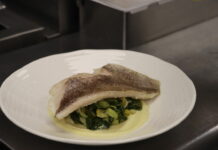“Kara and I were wondering if you would consider giving her cooking lessons,” my neighbor Kai said. It was late morning, and I was tugging weeds in the front garden, thinking about where to plant the portulacas. I was hot and grimy. I was not thinking about food.
“Cooking lessons?”
“Uh-huh,” said Kai. “Kara wants to learn how to cook, and we thought maybe you could teach her. It always smells so good in your kitchen when we come home.”
“Um, I don’t know. I mean, maybe,” I said. “I’ve just never taught anyone to cook before.”
Teaching someone to cook seemed oddly daunting to me, though I wondered why it should. I’ve taught writing to college students and simple embroidery to 9-year-old girls. I’ve even led a few wine tastings. Should teaching someone how to chop and sauté and simmer be much different from explaining a thesis statement or a chain stitch?
As I made dinner that night, I considered that question. While in some arts— writing for sure— there is no blueprint, no instruction you can follow so that your essay or poem or story comes out exactly like mine, cooking is teachable in a discrete way. It’s a lot like sewing (so much so that I often say recipe when I mean pattern): someone with very basic skills and a desire to learn can follow directions and come up with a decent (and reproducible) pan of brownies or a beginner’s nine-patch square.
Some cooks begin and end with brownies, of course. But those with the cooking bug build on their basic skills and add to their techniques, and somewhere along the line they become cooks rather than people who can follow a recipe.
My own cooking repertoire derives as much from my years of recipe collecting as it does from the cooks who mentored me. When I was too young to do too much in the kitchen, my mother and grandmother showed me how to grind nuts for nutrolls in the manual grinder. As I got older, I snapped string beans, peeled apples and pushed cookie dough off the edge of a teaspoon and onto a cookie sheet with my finger just as my mother did. My knife technique, such as it is, came from watching television chefs like Jacques Pépin rock a knife back and forth over fat cloves of garlic, reducing them to a buff-colored mince. And my habit of adding the strongest, tear-inducing Dijon mustard I can find to my vinaigrette comes from my friend Odile, who learned this trick from her stepmother.
I thought, too, of why I’ve always loved to cook. Part of it is the pure pleasure of doing things with my hands. Part of it is the innate creative process of making one thing from many or discovering that flavors like mint and basil go perfectly together. And while I certainly have days when cooking dinner seems like one more obligation, I’m thankful for the grace of being able to feed and take care of people I love. Making and preparing food has become no small measure of the relationship I have with my husband, my family, my friends. By the time the water boiled for my pasta and the garlic had browned, I’d realized that far from being a scary or overwhelming task, showing Kara how to cook was an opportunity to share what others had taught me. It felt both immensely flattering and oddly humbling.
I also realized that before I started thinking puff pastry and hollandaise sauce, I needed to know what Kara wanted to learn. She e-mailed to say that her current cooking skills were limited to boiling water, chopping vegetables and recently discovering the olive oil/garlic/onion trifecta. The only meals she cooked at home were spaghetti and mac & cheese. What she wanted was to learn how to make a meal that would fit both her limited skills and her limited time.
I racked my brain and my recipe trove and came up with a one-dish meal of chicken, potatoes and tomatoes that I had made many, many times and still loved. On a Friday afternoon at the appointed time I went next door with a shopping bag full of produce, a jar of olives and my chef’s knife wrapped up in a kitchen towel. I felt a little like a Julia Child who makes house calls.
Kara answered the door already wearing a “hon” apron and took me into the kitchen where she pointed proudly to the thawed chicken breast she’d remembered to take out of the freezer. We unpacked my bag, got out two cutting boards, set up the recipe so we both could see it, and proceeded side by side to go through the recipe. “You can smash the clove of garlic with the broad part of the knife so the papery skin comes off,” I said, as we pressed, peeled and chopped.
We sliced lemons and olives, tomatoes and potatoes and tossed everything with a little olive oil before tucking the vegetables in among the chicken breasts. As the chicken baked, we talked about using the recipe as a base for other dishes by substituting turkey sausage for chicken, or oranges for lemons and sweet potatoes and squash for the other vegetables. I mentioned couscous as a side dish, and Kara opened the cabinet to reveal several boxes of couscous and quinoa. I suggested taking whatever vegetables she had and adding them raw or sautéed to the couscous. “You can even toast some nuts and add them in,” I said, eyeing the toaster oven. All the while Kara nodded and murmured, “Yes!”
I left Kara while she was still in awe of the fragrance coming from her oven, hoping the dinner would please. I found out my answer the next morning. “Oh my gosh, Mary,” gushed Kai over the back fence. “That was so delicious. Kara did a great job.”
I think Kara and I both wanted to believe she would become a confident cook after our lesson, especially when I ran into her later that afternoon with an armful of cookbooks from the library. But when she e-mailed me a week or so later for a copy of the recipe we cooked together, and I asked what she had been making lately, her answer was “reservations at the new Food Market restaurant in Hampden.” “I must make time to cook,” she added.
I think she will. She just might need another recipe… and another lesson. I’m already planning the syllabus.
Chicken Roasted with Tomatoes,
Potatoes and Olives
This recipe is adapted from one originally published in the now-defunct Gourmet magazine in 1996.
7 garlic cloves
¼ teaspoon of salt
2 teaspoons fresh lemon juice
3 tablespoons olive oil
1 large lemon, sliced thin
1 ½ pounds boneless, skinless chicken breasts
1 pound small red potatoes
4 plum tomatoes halved lengthwise
10 Kalamata or other black olives, pitted
1 tablespoon fresh rosemary leaves or 1 teaspoon dried rosemary, crumbled
Preheat oven to 450 degrees and oil a 13-by-9-inch shallow baking pan.
Mince and mash 2 garlic cloves to a paste with salt. In a small bowl, whisk together garlic paste, lemon juice and 2 tablespoons oil with salt and pepper. In pan make 2 beds of overlapping lemon slices and put a chicken breast half on each bed. Brush chicken generously with garlic lemon mixture and season with salt and pepper.
Quarter potatoes and in a bowl toss with tomatoes, remaining 5 whole garlic cloves, and remaining tablespoon oil until coated well. Arrange vegetables around chicken and sprinkle chicken with olives and rosemary.
Roast chicken and vegetables in middle of oven 15 minutes and brush with remaining garlic lemon mixture. Roast chicken 10 to 15 minutes more, or until cooked through.
Discard lemon slices and serve chicken with vegetables, spooning any pan juices over them. Serves 4.




